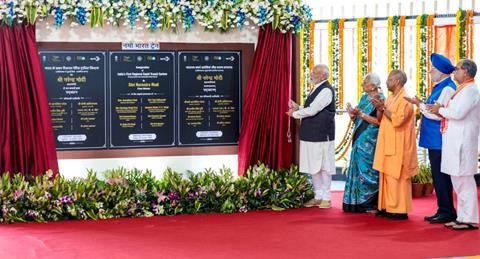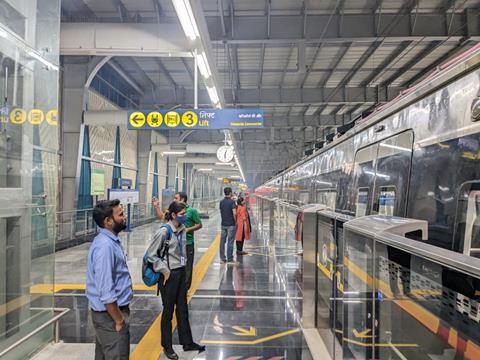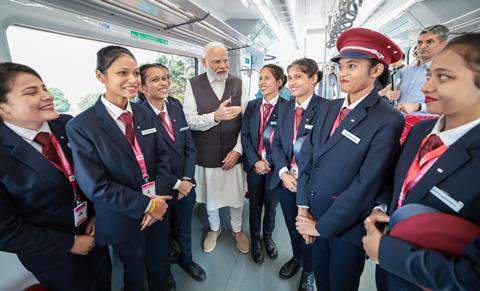
INDIA: Passenger services on the initial section of the Delhi – Ghaziabad – Meerut Regional Rapid Transit System began on October 21, after the line had been inaugurated by Prime Minister Narendra Modi the previous day.
The first section of the stand-alone Delhi – Ghaziabad – Meerut commuter railway runs 17 km from Sahibabad Ghaziabad, Guldhar Duhai and Duhai Depot. Modi said the section to Meerut would follow in around 1½ years. The entire 82 km corridor is expected to be commissioned by June 2025.
Modi said the opening of what is now branded as RapidX, was a historic moment for the country, which provided a ‘glimpse of India of the future and exemplifies the transformation of the nation with growing economic muscle’. He had laid a foundation stone for the line on March 8 2019, and said the opening showed the government’s commitment to inaugurating such projects.
RRTS corridor

Eight RRTS corridors have been identified to promote more balanced and sustainable development in the National Capital Region, with three prioritised for implementation (Table I).
| RRTS corridors identified to be developed in the National Capital Region |
|---|
| First phase |
| Delhi – Ghaziabad – Meerut, 82 km |
| Delhi – Gurugram – Shahjahanpur-Neemrana-Behror urban complex – Alwar, 198 km |
| Delhi – Panipat, 103 km |
| Later phases |
| Delhi – Faridabad – Ballabgarh – Palwal (Haryana) |
| Ghaziabad – Khurja (Uttar Pradesh) |
| Delhi – Bahadurgarh – Rohtak (Haryana) |
| Ghaziabad – Hapur (Uttar Pradesh) |
| Delhi – Shahdara – Baraut (Uttar Pradesh) |
The Delhi – Ghaziabad – Meerut line is being developed by the National Capital Region Transport Corp at an estimated cost of Rs302·74bn. NCRTC is joint venture of the national government and the state governments of Delhi, Haryana, Rajasthan and Uttar Pradesh.
The line is being built to the international standard 1 435 mm gauge, as are most Indian metro lines, rather than the 1 676 mm broad gauge of India’s national rail network, and is electrified at 25 kV 50 Hz. The alignment has been designed for 180 km/h, with trains running at up to 160 km/h in service to give a future end-to-end journey time of less than 1 h.
Services are being run by Deutsche Bahn International Operations under a 12-year Rs14·93bn contract awarded by NCRTC in July 2022. DB RRTS Operations India has recruited 350 staff, of which 25% are female.
‘We are working here in one of the largest urban areas in the world’, said Niko Warbanoff, CEO of parent company DB ECO. ‘India has an enormous task ahead of it in promoting sustainable urban development. We are therefore proud of our team of experts, who have made it possible to get the first part of the new rail network successfully up and running so quickly.
Stations

Services will run every 15 min, potentially increasing to every 5 min, and future ridership on the full route is predicted to be 800 000 passengers/day.
The 22 stations will offer interchange with existing rail, metro and bus services, as part of a strategy to boost economic activity in the region, improve access to employment, education and healthcare and reduce road congestion and air pollution.
The stations are provided with platform screen doors, and also have tactile guidance and security systems including CCTV, metal detector gates and X-ray luggage scanners. The toilets are provided with baby changing facilities. The colour scheme is inspired by peacocks.
Women are expected to comprise half of the total staff at stations.
Digital and paper QR Code tickets are available, along with EMV open loop contactless card payment.
Trains

On May 2020 NCRTC awarded Bombardier Transportation a Rs25·8b contract to supply the rolling stock, signalling and control systems, platform screen doors and telecoms and provide 15 years of maintenance. The order included 30 six-car EMUs to operate regional services over the full route, and 10 three-car ‘high capacity’ units for local services on the 21 km 13-station section between Meerut South and Modipuram Depot.
Having subsequently acquired Bombardier Transportation, Alstom said it undertook ‘end-to-end’ engineering and manufacturing of the fleet in India, incorporating worldwide experience. The rolling stock from its Adessia commuter train family was designed at its Hyderabad engineering centre and is being assembled at Savli. Traction and electrical systems are being supplied from the group’s Maneja factory.
The styling of the trains has been inspired by Delhi’s Lotus Temple. Each six-car EMU has five standard class coaches, including one reserved for women; these have 72 red coloured seats per car. There is also a premium coach with 62 blue reclining seats, more leg room, footrests, coat hooks, magazine holders. Premium fares range from Rs40 to Rs100, compared to and fares of Rs20 to Rs50 for Standard class. The end coaches are provided with wheelchair spaces,
The government has branded the fast commuter trains as Namo Bharat, following on from the Vande Bharat trainsets ordered by Indian Railways for its inter-city services.
Signalling

Alstom said the project marked the world debut of ETCS Level 3 Hybrid train control using LTE communications. The system adds short virtual sections onto an ETCS Level 2 installation to allow operation at closer headways down to 180 sec. Deployment of automatic train operation over LTE is planned to increase performance and capacity in the future.
‘RapidX will be a first-of-its-kind experience for Indian commuters for its speed, advanced technology and passenger experience’, said Olivier Loison, Managing Director of Alstom India.
‘This project also marks the world premiere of several new signalling technologies which will set new benchmarks in the rail space globally. All of this is set to make sustainable mobility at scale real in India.’
| Delhi – Ghaziabad – Meerut RRTS project suppliers | |
|---|---|
| Alstom | Rolling stock, signalling and control systems, platform screen doors and telecoms (including 15 years of maintenance) |
| Deutsche Bahn International Operations | Operations |
| Nokia | LTE/4·9G private wireless communications network |
| Wabtec | Braking systems, pantographs, roof disconnector switches and passenger information systems |
| Teltronic | Communications equipment and control centre technology |

















